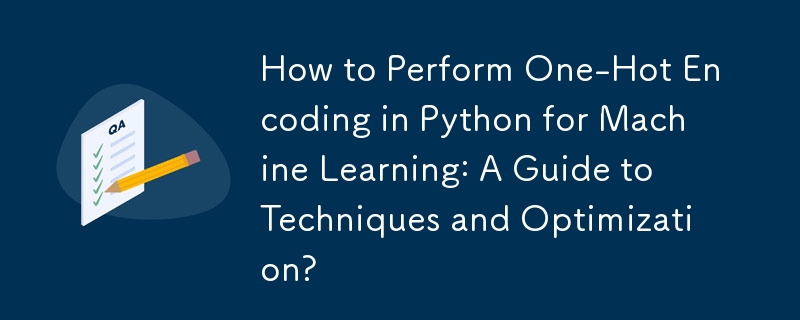 Backend Development
Backend Development
 Python Tutorial
Python Tutorial
 How to Perform One-Hot Encoding in Python for Machine Learning: A Guide to Techniques and Optimization?
How to Perform One-Hot Encoding in Python for Machine Learning: A Guide to Techniques and Optimization?
How to Perform One-Hot Encoding in Python for Machine Learning: A Guide to Techniques and Optimization?

How to Perform One-Hot Encoding in Python
One-hot encoding is a technique used to transform categorical variables into binary vectors. This is often necessary for machine learning classification problems, as many classifiers require numerical features.
Recommendation for Your Situation
In your case, since your data has a high percentage of categorical variables, it is recommended to use one-hot encoding. Without encoding, the classifier may not be able to understand the relationships between the different categories.
Using Pandas for One-Hot Encoding
One approach is to use the pd.get_dummies() method from the Pandas library. This method converts categorical variables into separate dummy variables.
import pandas as pd
data = pd.DataFrame({
'cat_feature': ['a', 'b', 'a']
})
encoded_data = pd.get_dummies(data['cat_feature'])Using Scikit-Learn for One-Hot Encoding
Another option is to use the OneHotEncoder class from Scikit-learn. This class provides more fine-grained control over the encoding process.
from sklearn.preprocessing import OneHotEncoder encoder = OneHotEncoder(sparse=False) encoded_data = encoder.fit_transform(data[['cat_feature']])
Troubleshooting Encoding Issues
If you encounter performance issues during the encoding process, try the following:
- Reduce the number of categories: If your categorical variables have a large number of unique categories, it will create a large number of dummy variables. Consider combining similar categories or using hierarchical encoding.
- Use sparse encoding: Sparse encoding creates a sparse matrix, which can save memory and improve performance for large datasets. Set sparse=True in pd.get_dummies() or use the SparseRepresentation class in Scikit-learn.
- Optimize your code: Use vectorized operations to improve efficiency. Consider using numpy or other optimized libraries for performance-intensive operations.
The above is the detailed content of How to Perform One-Hot Encoding in Python for Machine Learning: A Guide to Techniques and Optimization?. For more information, please follow other related articles on the PHP Chinese website!

Hot AI Tools

Undresser.AI Undress
AI-powered app for creating realistic nude photos

AI Clothes Remover
Online AI tool for removing clothes from photos.

Undress AI Tool
Undress images for free

Clothoff.io
AI clothes remover

Video Face Swap
Swap faces in any video effortlessly with our completely free AI face swap tool!

Hot Article

Hot Tools

Notepad++7.3.1
Easy-to-use and free code editor

SublimeText3 Chinese version
Chinese version, very easy to use

Zend Studio 13.0.1
Powerful PHP integrated development environment

Dreamweaver CS6
Visual web development tools

SublimeText3 Mac version
God-level code editing software (SublimeText3)

Hot Topics
 How to solve the permissions problem encountered when viewing Python version in Linux terminal?
Apr 01, 2025 pm 05:09 PM
How to solve the permissions problem encountered when viewing Python version in Linux terminal?
Apr 01, 2025 pm 05:09 PM
Solution to permission issues when viewing Python version in Linux terminal When you try to view Python version in Linux terminal, enter python...
 How to avoid being detected by the browser when using Fiddler Everywhere for man-in-the-middle reading?
Apr 02, 2025 am 07:15 AM
How to avoid being detected by the browser when using Fiddler Everywhere for man-in-the-middle reading?
Apr 02, 2025 am 07:15 AM
How to avoid being detected when using FiddlerEverywhere for man-in-the-middle readings When you use FiddlerEverywhere...
 How to efficiently copy the entire column of one DataFrame into another DataFrame with different structures in Python?
Apr 01, 2025 pm 11:15 PM
How to efficiently copy the entire column of one DataFrame into another DataFrame with different structures in Python?
Apr 01, 2025 pm 11:15 PM
When using Python's pandas library, how to copy whole columns between two DataFrames with different structures is a common problem. Suppose we have two Dats...
 How to teach computer novice programming basics in project and problem-driven methods within 10 hours?
Apr 02, 2025 am 07:18 AM
How to teach computer novice programming basics in project and problem-driven methods within 10 hours?
Apr 02, 2025 am 07:18 AM
How to teach computer novice programming basics within 10 hours? If you only have 10 hours to teach computer novice some programming knowledge, what would you choose to teach...
 How does Uvicorn continuously listen for HTTP requests without serving_forever()?
Apr 01, 2025 pm 10:51 PM
How does Uvicorn continuously listen for HTTP requests without serving_forever()?
Apr 01, 2025 pm 10:51 PM
How does Uvicorn continuously listen for HTTP requests? Uvicorn is a lightweight web server based on ASGI. One of its core functions is to listen for HTTP requests and proceed...
 How to handle comma-separated list query parameters in FastAPI?
Apr 02, 2025 am 06:51 AM
How to handle comma-separated list query parameters in FastAPI?
Apr 02, 2025 am 06:51 AM
Fastapi ...
 How to solve permission issues when using python --version command in Linux terminal?
Apr 02, 2025 am 06:36 AM
How to solve permission issues when using python --version command in Linux terminal?
Apr 02, 2025 am 06:36 AM
Using python in Linux terminal...
 How to get news data bypassing Investing.com's anti-crawler mechanism?
Apr 02, 2025 am 07:03 AM
How to get news data bypassing Investing.com's anti-crawler mechanism?
Apr 02, 2025 am 07:03 AM
Understanding the anti-crawling strategy of Investing.com Many people often try to crawl news data from Investing.com (https://cn.investing.com/news/latest-news)...





